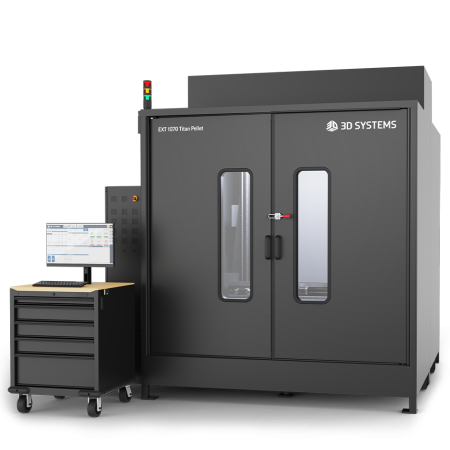The Brumos Racing Porsche GT2 RS Clubsport racecar, which clinched victory and set records in the Time Attack 1 Class at the 2023 Pikes Peak International Hill Climb (PPIHC), featured a 3D printed radiator air intake duct produced on 3D Systems’ EXT 1070 Titan Pellet printer. Airtech, a leader in 3D printed composite tooling and a pellet feedstock manufacturer, partnered with the 3D Systems Application Innovation Group (AIG) in Colorado Springs to print the duct using Airtech’s Dahltram pellets.
Photo by Larry Chen
3D printing end-use components for the car has definitely given us a competitive advantage.—David Donohue, Driver
Brumos Racing Porsche GT2 RS Clubsport racecar front end (bumper removed to show the 3D printed intake duct)
CAD rendering of the duct model.
Background: Building a Better Race Car
The Brumos race team has leveraged 3D printing to improve the design and aerodynamics of the car since 2022 by using 3D printed tooling for composite layup molds and smaller end-use parts on the car. But until this year, the team lacked the means to produce larger one-piece components due to scale limitations of their in-house 3D printers. Consequently, the duct had to be designed in three pieces with two structural partitions and required bonding flanges for the printed pieces to be joined together. The assembled duct, used in the 2022 race, served its purpose but suffered from stress cracks during testing and competition. These cracks had the potential to negatively impact the car's downforce and cooling efficiency, and in severe cases, could lead to complete part failure. Repairs, such as gluing or last-minute tape fixes, were often required.
Radiator intake duct being printed on EXT 1070 Titan Pellet 3D printer
Solution: Design Improvements and Large-Format Printing
For the 2023 race, driver, David Donohue, and Dmitry Orlov of BBI Autosports collaborated closely to design the new, lighter one-piece duct, incorporating reinforcing ribs, integrated mounting brackets, mounting flanges, and revised geometries to accommodate updated splitter mounting brackets and chassis air jacks. Airtech provided 3D Systems’ AIG with a pre-commercial version of their carbon fiber reinforced high-performance polyamide resin pellets. 3D Systems was able to quickly develop printing parameters that delivered a high-quality, high-resolution part with the strength needed for the end-use application.
“The EXT Titan Pellet platform was perfect for scale, environment, and throughput,” said Gregory Haye, Director of Additive Manufacturing at Airtech. “Big enough to do these kinds of components with extruder throughput high enough to get the best layer bonding, supplemented by the heated chamber and bed.”
Using the 3D Systems EXT 1070 Titan Pellet 3D printer, the 32” wide x 12” tall bumper radiator inlet duct was successfully printed in just 36 hours. The Titan systems’ advanced pellet extruder, heated print bed and actively heated chamber ensured precise temperature control resulting in excellent dimensional stability, accuracy, and layer adhesion, leveraging the performance of the Airtech carbon fiber reinforced polyamide resin.
“The Hill Climb takes place in our backyard here in Colorado Springs, so we were excited to partner with Airtech and the Brumos Racing team on this project,” said Clay Guillory, Director of AIG for the EXT Titan Pellet division. “The car is a work of art and David is an unbelievably skilled driver. I’m thrilled we could play a part in his incredible victory.”
Driver David Donohue and the Brumos Racing Porsche GT2 RS Clubsport racecar.
Results: Record-Setting Success
The revised design, choice of materials, and advanced manufacturing approach not only demonstrated robustness in initial testing and qualification runs, but also survived Donohue’s record-setting race up America’s Mountain on June 25. Donohue took first place in the Time Attack division, fourth place overall, and broke the Time Attack 1 course record he set previously in 2019 by 20 seconds. He reached the 14,115’ summit and completed the 12.42-mile course, with its staggering 156 turns, in just 9 minutes, 18.053 seconds.
“Additive manufacturing allows for a quicker timeline and a lower budget, and in racing that’s everything. I think there’s a lot of resistance in this industry to using 3D printing, but obviously, it works,” said Donohue.
